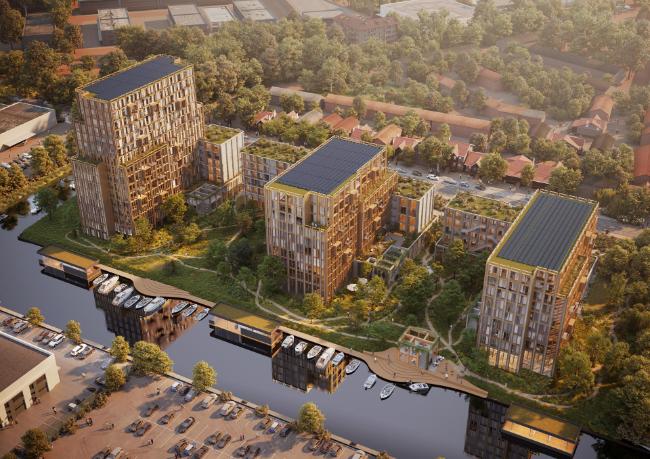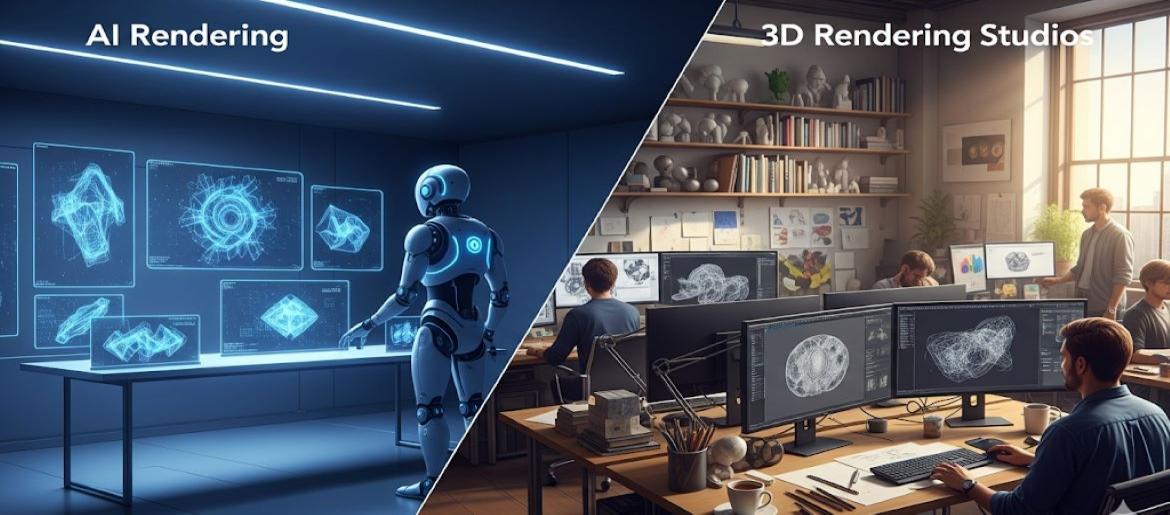AI rendering uses machine learning to create realistic architectural images more efficiently than traditional methods. Does this mean the end of 3D companies providing architectural rendering services to architects, product designers, branding agencies, interior designers, and real estate professionals?
This article examines whether AI can replace 3D rendering studios by exploring its capabilities and limitations.
The Role of 3D Visualization in Interior Design, Architecture, and Development
High-quality renders are paramount in architecture and development. These realistic renders bridge the gap between architectural planning and tangible reality, enabling architects and clients to visualize future projects as they would in real life. Renders help convey the architect’s intentions for architectural projects ranging from ambitious skyscrapers to cozy interiors, ensuring alignment between all parties. 3D rendering companies specialize in transforming flat sketches into vibrant, lifelike scenes that capture the design’s essence, materials, and, by using 3D rendering software, visualize the project as it would appear in reality. Renders often present the design through a single image, instantly as one shot. Photorealistic rendering services are helping stakeholders understand and engage with a project’s idea before construction begins.
These 3D solutions, like interior and exterior rendering images, virtual reality, and motion 3D solutions, enable the achievement of comprehensive project visualization. High-quality 3D renders can turn potential projects into real-life constructions, especially when first impressions matter for a company. 3D visualization can convey the overall presentation of the object, culminating in a final image that creates a lasting impact.

How AI Rendering Works
AI rendering, unlike traditional methods that rely heavily on manual input and extensive 3D modeling, leverages machine learning algorithms to enhance the creation of renders. This algorithm-based technology can transform the way architectural rendering services are provided, making the process more efficient and accessible.
AI’s Competitive Advantage in Architectural Rendering
AI rendering stands out for its efficiency in generating visual content. Traditional 3D rendering methods can be extremely time-consuming, often requiring hours or even days to produce a single image. In contrast, AI can generate high-quality visualizations in a fraction of the time, providing a significant competitive advantage. However, these outputs are often not on the same level as realistic visualizations created by 3D studio experts. They are not accurate, contain mistakes, and require improvement in traditional 3D rendering software and later corrected during post-processing by 3D rendering professionals.
Another key capability of AI is the automation of repetitive tasks and design iterations, especially when AI already is provided with existing visual content, such as a design already rendered as a 3D image, because it can then generate an algorithm from it. For instance, AI can quickly adjust finalized renders, including lighting, people, vegetation, textures, and other elements, based on user inputs.
This allows for rapid experimentation and refinement of designs. This automation not only speeds up the 3D rendering process but also frees up 3D artists to focus on more creative aspects of their projects. In this case, it is also essential to check the outcome, as AI rendering adjustments tend to have many mistakes.
Limitations of AI in Architectural Visualization and Photorealistic Rendering Services
While AI rendering offers numerous benefits, it also comes with its own set of challenges. One of the primary limitations is its difficulty in interpreting the complexity of design nuances. Architectural designs often involve intricate details and creative elements that AI algorithms may struggle to replicate accurately. This can result in visualizations that lack the unique touch and artistic flair that human designers bring to their work.
Another significant limitation is the potential loss of creative or artistic elements. AI, by its nature, relies on patterns and data-driven approaches, which can sometimes stifle creativity. Human 3D artists and 3D rendering companies have an innate ability to think outside the box, understand the context, and infuse their projects with originality and stylistic innovation. This creative intuition is something that AI, despite its advancements, cannot replicate.
Data accuracy and dependency also pose challenges for AI rendering. AI algorithms are only as good as the data they are trained on, and any inaccuracies in the input data can lead to flawed visualizations. While it excels in speed and efficiency, it can sometimes lack consistency and predictability in its final outputs, making it more suited for ideation phases rather than completed presentations.
These limitations highlight the importance of human expertise in the architectural visualization process. While AI can enhance efficiency and provide valuable tools for preliminary design phases, the final touches and creative decisions still heavily rely on human judgment and experience. AI rendering is a powerful tool, but it is not a standalone solution for all architectural visualization needs. Understanding these nuances can make all the difference in choosing the best solutions for each project phase and in effectively integrating AI into the architectural visualization workflow.

The Hybrid Approach: Integrating AI with Human Expertise of 3D Architectural Rendering Studios
The most effective approach to architectural visualization lies in integrating AI tools with human expertise. Combining the strengths of AI with the professional judgment of experienced 3D rendering artists can significantly enhance productivity without compromising quality. This hybrid approach leverages the best of both worlds, ensuring that the final product design is both efficient and creatively fulfilling.
In practice, AI handles time-consuming tasks, while human 3D rendering artists can focus on refining these elements, adding creative touches, and making critical postproduction decisions. This collaborative workflow allows architectural rendering services studios to deliver high-quality visualizations more quickly and efficiently.
Various 3D rendering companies and architectural visualization studios employ this hybrid approach. They streamline processes with AI while relying on an art director and experienced 3D rendering artists to maintain high standards in final 3D renderings. Combining technology and human talent is key to maintaining the quality and creativity clients expect.
Conclusion: AI as a Tool Next to 3D Rendering Software, Not a Replacement for 3D Rendering Studios
In summary, while AI rendering offers remarkable advancements in efficiency, it is not poised to replace traditional 3D rendering studios entirely. The role of high-quality visualizations in architecture remains critical, and AI can enhance but not entirely replicate the creative and artistic elements that human 3D artists bring to the table.
The optimal approach lies in a hybrid model where AI and human expertise work in tandem. This ensures that architectural projects benefit from the best of both worlds: the efficiency of AI and the creativity used as a tool, as well as the understanding and context-driven thinking of skilled 3D professionals.































